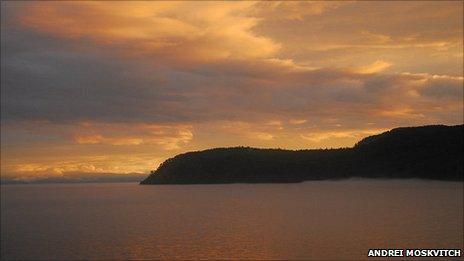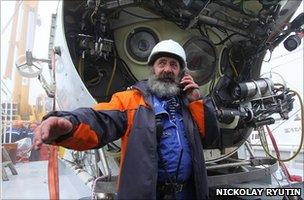Russian subs dive deep for new energy sources
- Published
Yevgenii Chernyaev takes his sub deep into Lake Baikal
Russia has some of the largest energy reserves in the world, but it keeps searching for new sources - even if it means going underwater.
Two Russian deep-water submersibles have once again taken a dive in Lake Baikal, to study recently found fields of gas hydrates, a possible fuel of the future.
Baikal is the world's deepest, oldest freshwater basin and one of the most biologically diverse.
Located in East Siberia close to the Mongolian border, the lake holds one-fifth of our planet's surface fresh water.
The vessels dubbed Mir - which is Russian for "world" - belong to Russia's Shirshov Institute of Oceanology of the Russian Academy of Sciences (RAS).
In 1996, Unesco awarded Baikal World Heritage Site status and placed its fragile environment under international protection.
On past voyages, the Mir discovered new organisms endemic to Baikal, as well as important deposits of gas hydrates and sites with oil formation.
From July until September, the tiny, 20 tonne oval-shaped subs and their three-member crews plan to perform about 60 submersions that will last several hours each.
They navigate through the lake's deep blue more than 1.5km underwater, but are able to go down to 6,000m.

Only a handful of sumersibles can dive as deep
Only two other submersibles can go to such depths - French Nautile and Japanese Shinkhai.
The expedition brings together Russia's most renowned oceanographers, biologists, geologists and other scientific minds - and possibly the Canadian film-maker James Cameron.
He used the Mir subs to film his epic Titanic in 1997, submerging some 3,800m to the wreckage of the sunken ship, lying on the bottom of the Atlantic Ocean.
Last year, the Russian premier Vladimir Putin went on a four-hour dive in Baikal with the scientists, and next summer, the subs' crews plan to bring the vessels to Europe, to explore Lake Geneva, Switzerland.
During this summer's venture, researchers hope to further analyse recently discovered sites of sub-bed gas hydrates.
These crystalline water-based solids look like ice and inside them are huge amounts of gases - biochemical methane and traces of nitrogen, carbon dioxide and ethane.

Lake Baikal holds one fifth of the world's surface fresh water
The gases are trapped in "cages" of hydrogen-bonded water molecules.
Usually gas hydrates form in permafrost or in deep oceans. Scientists believe they exist in Baikal due to the lake's huge depths and the low temperatures of the sub-bottom water.
There is thought to be much more gas in these unconventional energy deposits than in all known natural gas reserves.
But researchers say a lot more research is needed for them to be able to extract gas from unstable hydrate accumulations.
The specific density of gas hydrates is lower than that of water, and when released, they float to the surface and disintegrate into water and gas as the pressure falls.
Looking at the lake's blue waters, sparkling in the evening sun, Alexander Yegorov of the Oceanology institute said that studying gas hydrates in Baikal gives researchers a unique opportunity to find out more about this possible alternative fuel source.
"Baikal is like a laboratory to verify scientific hypotheses and to study the behaviour of gas hydrates in the World Ocean," he said.
"This opens great possibilities for us - now we can study how gas hydrates form and how we can extract them - in the ocean of course, as I hope no one will start extracting them from Baikal."
It is rather difficult to study gas hydrates in seas and oceans, he explained, but in Baikal, the deposits lie directly on the lakebed and there is no need for drilling to access them.
Dr Yegorov said that last year scientists studied how gas hydrates floated from the bottom to the surface, and during the current season the aim is to analyse these processes even further.
"We also discovered a very interesting phenomenon of how gas hydrate bubbles that come from the lakebed turn into tiny gas hydrate sand-like particles.
Fast, clever and unique - Lake Baikal's nerpa seals
"This gives us clues about gas hydrates' formation and lets us estimate whether they may really be considered an energy source for humanity," he added.
Pipelines through Baikal?
Besides discovering gas hydrates fields, last year the Mir also found multiple sites of oil formation.
Scientists say some four tonnes of crude oil naturally seep into Baikal every year from fissures in the lake's bedrock.
But Dr Yegorov stressed that this does not affect the lake and Baikal waters manage to stay very clean thanks to microorganisms that use oil as a food source.
"Baikal can be used to verify different processes and technologies, in particular those needed to prevent the consequences of an accident like the oil spill in the Gulf of Mexico.
"To be ready for such spills, we have to first study them and study how microorganisms clean the waters. And here we have a unique opportunity to do just that," said Dr Yegorov.
Most scientists exploring Baikal say that the lake will not and should not be used for oil and gas extraction for commercial purposes.
Nevertheless, during one of the past expeditions, representatives from Gazprom VNIIGAZ - the research institute of Russia's energy giant Gazprom - used the Mir to install a flag with the company's logo on top of an underwater volcano in a region abundant with gas hydrates.

This summer, the subs aim to study recently found deposits of gas hydrates
The subs also analysed soil behaviour in deep-water conditions with a potential impact on Baikal from underwater pipelines.
And though there are no real discussions as of yet about extracting gas and oil from this World Heritage site, microbiologist Tamara Zemskaya of the Limnological institute in Irkutsk believes that a gas pipeline would not harm Baikal's fragile environment.
"There is a gas pipeline being built in the Baltic Sea and if everything is done properly, one could run through the Baikal lakebed as well without any danger to the lake's ecosystem.
"It is not the right place for an oil pipeline, that's for sure, but a gas one would not be a problem," she said.
In 2006, under pressure from environmentalists, the then-president Vladimir Putin ordered a proposed oil pipeline through Baikal to be re-routed. An Irkutsk-based ecologist Marina Rikhvanova who campaigned for the pipeline plans to be dropped was awarded a prestigious Goldman Environmental prize for her efforts to save the lake.
'Pearl of Siberia'
Yevgenii Chernyaev is the captain of one of the vessels.
In 2007, he piloted Mir-2 down the icy waters at the North Pole to install a titanium flag on the Arctic floor. The manned subs reached the depth of 4,300m under a 2.5m layer of ice - something no one had done before. The expedition was widely reported as a bid to further Moscow's territorial claims in the Arctic.
Having left the sub after this summer's first submersion, which lasted only a few hours, Chernyaev stood on a barge in the middle of Baikal. The lake, the barge and the subs' crews were all wrapped in thick fog, common at this time of year.
Looking at the ring of mountains around the lake, Mr Chernyaev said 25-million-year old Baikal was still hiding quite a few secrets.
"When you go to Baikal, especially when you go underwater, it's as if you have arrived in some fairytale," he said.
"Nothing here is like anywhere else. Last summer, we discovered so much - including unique deposits of gas hydrates, a possible fuel of the future, and endemic organisms, found only in this lake.
"And I'm certain there are a lot more wonders down there," said Mr Chernyaev.
He also mentioned that the Russian subs might be the only means to cap the on-going oil leak in the Gulf of Mexico, but added that no-one had so far expressed real interest in the Russians' help.
At its deepest point of 1,637m, Lake Baikal is as deep as many places in the world's oceans.
The locals call the lake the Pearl of Siberia. It extends like an enormous deep crescent-shaped cut in the Earth's crust and holds the greatest amount of fresh water in the world - 23,000 cubic km.
A multitude of rivers, creeks and streams race down the rim of the nearby Eastern Sayan mountains and rocky cliffs of the Baikal range to fill the lake's green-blue waters.
Full of endemics
The lake is home to over 1,700 species of animals and plants, about two thirds of which are endemic to the lake - they can be found nowhere else in the world.
Out of more than 50 different fish species, at least half are native to Baikal. Among them are the omul and the golomyanka.

Lake Baikal still holds many secrets, say scientists
The golomyanka has no scales, its body is translucent and about a third of it is composed of oil. This unusual fish contains so much fat that, if left on a shore in sunlight, it will simply "melt" - all that will be left is its skeleton and some oil.
One of the animals that eats the golomyanka is another Baikal endemic - the world's only exclusively freshwater seal, the nerpa, that has lived in this lake for some two million years.
Although there is a small number of sub-species of ringed seals in other places, among them in Lake Lagoda in Russia, Saima Lake in Finland and a string of lakes in Northern Quebec, the nerpa is known to be the only indigenous freshwater seal.
How it got to Baikal from the salty oceans hundreds of kilometres away still remains a mystery.
Some scientists now tend to believe it came from the Arctic Ocean. To get to the lake, it could have either swum up the rivers or arrived by a sea-passage that had possibly formed after the ice age and then disappeared.
There are some 60,000 of these animals living primarily in the northern region of the lake around the Ushkany Islands, but in recent years the seals' numbers have declined, largely because of poaching.
This summer, the Mir will not be searching for the nerpa's origins, but microbiologist Zemskaya said scientists are keen to discover new, endemic organisms of the Siberian lake.
"During past expeditions, we found a species of freshwater nematode that is completely new to science," she said, explaining that it was a tiny worm.
"These organisms get their nutrition from hydrocarbons that rise from the bottom of Baikal. This is very interesting and new for this lake.
"Also, below the depth of over a kilometre we found bacteria that usually live no more than 20-50m under the surface because it needs sunlight to thrive. We would like to find out how they can be so active and thriving at such great depths," she said.
As the Mir team continues its venture, scientists worldwide will be waiting for the expedition to shed more light on the secrets of Baikal, this vast Siberian abyss.